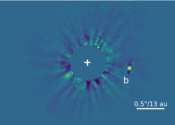Webb snaps supersonic outflow of young star
NASA's James Webb Space Telescope has captured a high-resolution look at Herbig-Haro 211 (HH 211), a bipolar jet traveling through interstellar space at supersonic speeds. At roughly 1,000 light-years away from Earth in the ...









